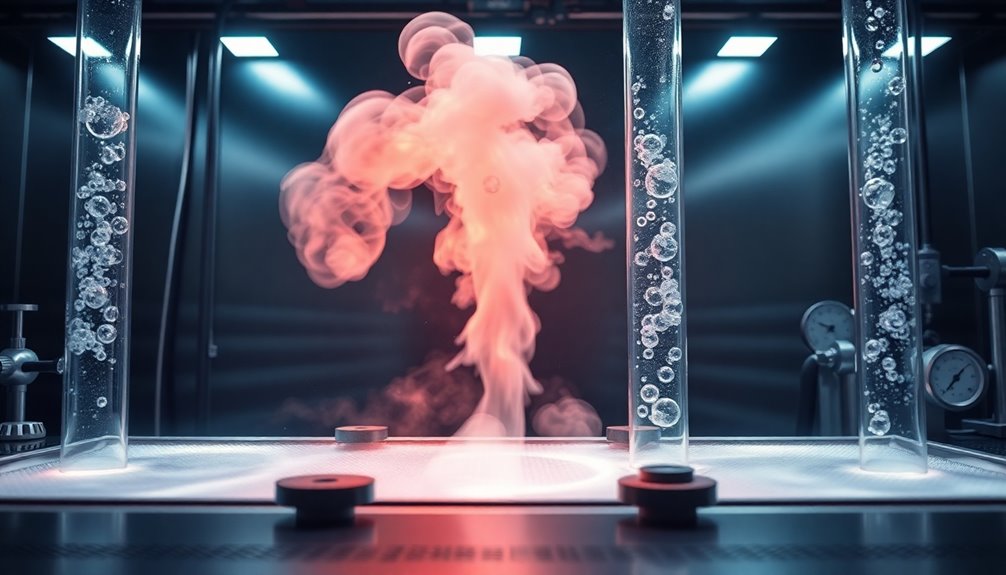Flow boiling heat transfer is all about managing the transition of liquid to vapor in flowing streams, which you can see in applications like electronics cooling and power generation. Key concepts include nucleate and convective boiling, along with distinct boiling regimes that affect heat transfer efficiency. Innovative techniques, like structured surfaces and advanced materials, are being explored to boost performance. If you're curious about the specifics and future directions in this field, there's more to discover.
Key Takeaways
- Flow boiling combines nucleate and convective boiling, crucial for efficient heat transfer in applications like electronics cooling and power generation.
- Various flow boiling regimes, including subcooled and saturated boiling, influence heat transfer efficiency through distinct characteristics and transitions.
- Key parameters such as mass velocity, vapor quality, and surface roughness significantly affect flow boiling performance and overall heat transfer rates.
- Innovative techniques, like structured surfaces and advanced materials, are being developed to enhance heat transfer coefficients in flow boiling systems.
- Future research focuses on optimizing new refrigerants and utilizing non-intrusive methods for studying flow boiling phenomena to address environmental challenges.

Flow boiling heat transfer is a fascinating process where a liquid transitions to vapor within a flowing stream, often found in tubes. This process combines nucleate boiling and convective boiling heat transfer mechanisms, providing efficient cooling in various applications. When you deal with low vapor qualities and high heat fluxes, nucleate boiling typically takes charge. However, as vapor quality and mass velocity increase, convective boiling becomes the dominant mechanism. Understanding these dynamics is crucial for evaluating flow boiling performance, especially through the heat transfer coefficient (HTC).
Flow boiling heat transfer efficiently transitions liquid to vapor, blending nucleate and convective mechanisms for optimal cooling performance.
You'll encounter different flow boiling regimes like subcooled flow boiling and saturated boiling. Subcooled flow boiling occurs when the bulk liquid is below its saturation temperature, while saturated boiling begins once the liquid reaches that critical temperature. Within these regimes, you'll find bubbly, slug, annular, and dryout flow patterns, each exhibiting distinct heat transfer characteristics. The transitions between these regimes can significantly affect overall heat transfer efficiency.
In flow boiling, nucleate boiling initiates bubble formation at the heated surface, while convective boiling enhances heat transfer through fluid motion. The microlayer evaporation beneath growing bubbles plays a vital role in this process. You'll notice that bulk flow influences bubble growth and departure, and bubble-induced convection further boosts heat transfer rates. Moreover, HPC clusters are increasingly being utilized to model and simulate flow boiling phenomena, enabling researchers to optimize these processes effectively.
Key parameters affecting flow boiling include mass velocity, vapor quality, and heat flux. The subcooling of the liquid can also impact the onset of boiling, while factors like surface roughness and material properties can enhance performance. This technology finds applications in electronics cooling, power generation, transportation thermal management, and even space applications.
Innovative techniques, such as structured surfaces and advanced materials, aim to enhance heat transfer coefficients. Research into new refrigerants and non-intrusive methods to study flow boiling is essential for future advancements. As you explore flow boiling, consider its potential for improving efficiency while addressing environmental challenges.
Frequently Asked Questions
What Materials Are Best for Flow Boiling Heat Exchangers?
When selecting materials for flow boiling heat exchangers, you can't go wrong with aluminum and copper.
Aluminum offers significant enhancements in heat transfer coefficients, especially with micro- and nanostructured surfaces, while copper provides high thermal conductivity for intense heat applications.
However, aluminum generally outperforms copper in flow boiling due to its better wettability and active nucleation sites.
Keep these properties in mind when choosing the right material for your specific needs.
How Does Flow Boiling Differ From Pool Boiling?
Flow boiling differs from pool boiling primarily in fluid motion.
In flow boiling, you have fluid circulation over a heated surface due to external forces, enhancing heat transfer through convection.
Pool boiling, on the other hand, relies on natural convection without bulk fluid flow.
While flow boiling can achieve higher heat transfer rates, pool boiling offers easier setup and maintenance, making it ideal for certain applications, especially where uniform heat distribution is crucial.
What Are Common Applications of Flow Boiling in Industry?
Imagine a bustling factory, where flow boiling cools high-performance electronics and keeps air conditioning systems running efficiently.
You'll find it in spacecraft, ensuring optimal thermal management during missions. In power generation, flow boiling cools nuclear reactors, enhancing safety.
As you drive your electric vehicle, flow boiling aids in thermal management, making it vital across multiple industries.
Its versatility and efficiency make it a cornerstone technology for modern applications.
How Does Surface Roughness Affect Flow Boiling Performance?
Surface roughness significantly affects flow boiling performance by providing more nucleation sites, which boosts heat transfer.
You'll notice that rough surfaces can enhance heat transfer coefficients by 20-35% at higher heat fluxes compared to smooth ones.
However, they can also increase frictional losses, impacting overall system efficiency.
Balancing the benefits of enhanced heat transfer with potential pressure drops is crucial for optimizing your flow boiling applications.
What Safety Concerns Are Associated With Flow Boiling Systems?
When you work with flow boiling systems, be aware of several safety concerns.
Premature critical heat flux can decrease efficiency and lifespan, while uneven heating may lead to equipment malfunctions, especially in critical settings like nuclear power.
Flow-induced vibrations can damage components, and local thermal stress might compromise material integrity.
To ensure stability and safety, you'll need to manage operational parameters and thermal-hydraulic conditions effectively.
Conclusion
In summary, flow boiling heat transfer is a vital process that enhances thermal management in various applications. By exploring innovative techniques, you can optimize efficiency and performance in systems like refrigeration or microelectronics cooling. For instance, consider a modern data center using advanced flow boiling techniques to regulate temperatures, significantly improving energy efficiency and equipment lifespan. As you dive deeper into this field, you'll uncover exciting opportunities for future advancements that can revolutionize heat transfer technologies.









